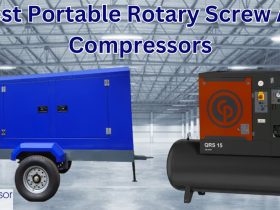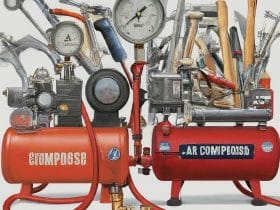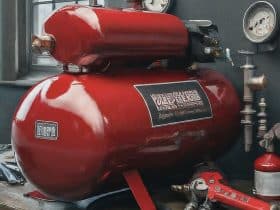Air compressors are versatile tools used for various tasks, from inflating tires and powering pneumatic tools to cleaning and painting projects. However, like any machine, they can experience problems that prevent them from working correctly. Instead of immediately calling a professional who comes with an expensive repair bill or buying a new one, learning some repair procedures and basic troubleshooting tips on how to repair air compressor can save you time and money.
This guide will walk you through diagnosing common air compressor problems and provide instructions for fixing them by step-by-step repair procedures and tips on how to prevent future problems.
Table of Contents
Safety First
Before diving into repairs, remember these crucial safety precautions:
- Always unplug: Before working on your compressor, disconnect it from the power source to prevent accidental starts.
- Release pressure: Drain the air tank entirely. Stored air pressure poses a risk during repairs.
- Mind the heat: Some components might get hot during operation. Allow the compressor to cool down before working on it.
Troubleshooting: Identifying the Problem
The first step in repairing your air compressor is to understand what’s wrong with it. Here are some common issues and how to diagnose them:
Compressor Won’t Start:
- Check the power source, including the outlet, extension cords, and circuit breaker.
- Examine the pressure switch, which turns the compressor on and off. Look for loose connections or a faulty switch.
- Inspect the motor capacitor, which helps the motor start. A faulty capacitor can prevent the motor from running.
- Check the thermal overload switch. This protects the motor from overheating and might have tripped, preventing the compressor from starting.
Compressor Runs But Won’t Build Pressure:
- Check the air filter. A clogged filter restricts airflow, hindering pressure buildup.
- Inspect the head gasket. A blown head gasket allows air to leak and prevents the compressor from reaching proper pressure.
- Examine the intake and exhaust valves. These valves, located within the compressor head, must seal properly. Broken or worn valves will affect pressure buildup.
- Check the piston rings. Damage to the piston rings causes air loss and reduced pressure.
- Look at the tank check valve. This valve prevents compressed air from flowing back into the compressor. A faulty check valve can create pressure issues.
Compressor Runs Constantly:
- Search for air leaks. Leaks in connections, hoses, the tank, or even the pressure switch can make the compressor run continuously to maintain pressure.
- Inspect the unloader valve which is designed to release pressure from the output line when the compressor reaches its cut-out pressure. A faulty unloader valve may not be doing its job.
- Examine pressure switch settings. Ensure the cut-in and cut-out pressures are within the appropriate range for your compressor.
Compressor Cycles On And Off Too Frequently:
- Check the pressure switch settings – adjustments might be needed.
- Assess the tank size. If the tank is too small for the tasks you perform, the compressor will cycle frequently.
- Look for air leaks in the system as these will cause more frequent compressor cycling.
Excessive Noise Or Vibration:
- Check for loose bolts or fasteners throughout the compressor.
- Inspect for worn bearings or damaged connecting rods inside the motor, which can cause unusual noise.
Repair Procedures
Once you’ve pinpointed the issue, here are some common repair procedures you might need:
Replacing a Pressure Switch:
- Unplug the compressor and drain the air tank.
- Remove the pressure switch cover.
- Take note of the wiring connections and then disconnect the wires.
- Remove the old pressure switch using a wrench.
- Apply thread sealant tape to the threads of the new pressure switch.
- Install the new pressure switch and tighten securely.
- Reconnect the wires in their correct positions.
- Replace the pressure switch cover.
Fixing Air Leaks:
- Build up pressure in the air tank.
- Use a mixture of soap and water and apply it to all connections, hoses, valves, and the tank itself.
- Look for bubbles, which indicate a leak.
- Tighten loose fittings or replace damaged components.
- Ensure proper sealing by using thread sealant tape where necessary.
Replacing Intake and Exhaust Valves:
- Unplug the compressor and ensure the air tank is empty.
- Remove the compressor head to access the valves.
- Carefully remove the old intake and exhaust valves. Pay close attention to their orientation for proper reinstallation.
- Clean the mating surfaces where the valves sit with a razor blade or gasket scraper.
- Install the new valves, making sure they are seated correctly and in the right direction.
- Reinstall the compressor head, ensuring a new gasket is used for a proper seal.
Checking a Thermal Overload Switch:
- Unplug the compressor and drain the tank.
- Locate the thermal overload switch, usually near the motor.
- Use a multimeter to test for continuity across the switch. If there’s no continuity, the switch is faulty and needs replacement.
Additional Tips On How To Repair Air Compressor
- Consult the owner’s manual: Your air compressor’s manual is a goldmine of information. It will include model-specific instructions, troubleshooting guides, and parts diagrams.
- Take pictures during disassembly: If you need to disassemble parts of your compressor, taking photographs before and during the process is a lifesaver when reassembling.
- Cleanliness is crucial: When working on the internal components of your air compressor, ensure the parts and your work area are clean. Any dirt or debris can lead to more problems.
- Know your limitations: If you feel uncomfortable with any repair or find the problem beyond your expertise, reach out to a qualified technician. Messing with a complex device while unsure can create additional damage.
Preventative Maintenance: The Key to Longevity
To reduce the chance of future breakdowns and extend the life of your air compressor, follow these preventative maintenance tips:
- Drain the tank regularly: Moisture buildup in the air tank can lead to rust and other problems. Drain the tank frequently, especially in humid environments.
- Change the air filter: Follow your manual’s guidelines for replacing the air filter. Keeping the filter clean optimizes performance and prevents strain on the compressor.
- Check oil levels (oil-lubricated models): Refer to your manual for proper oil levels and change intervals. Maintaining proper lubrication is crucial for smooth operation.
- Inspect hoses and connections: Regularly look for cracks or leaks in hoses and ensure all connections are tight.
When to Call a Professional
While troubleshooting and fixing common issues yourself can be rewarding, some situations call for professional assistance:
- Major electrical problems: If you suspect serious electrical issues with the motor or wiring, it’s safest to enlist the help of an electrician or a qualified air compressor technician.
- Extensive internal damage: If your compressor requires major internal repairs, such as replacing the piston, crankshaft, or complex valve assemblies, you might need the expertise of a professional.
- Persistent issues: If you can’t identify the problem or if your repairs don’t solve the issue, don’t hesitate to seek professional service.
Conclusion
By following these repair procedures and troubleshooting tips on how to repair air compressor, you’ve gained valuable knowledge that will continue to serve you well. Not only can you save money by addressing air compressor issues yourself, but you’ve also developed a better understanding of this useful tool. Remember, regular maintenance is key to preventing future problems, so consult your owner’s manual and keep those preventative measures in mind!
FAQs About How To Repair Air Compressor
Q 1: My air compressor won’t turn on. What should I do?
Answer: Start by checking the basics:
1. Ensure it’s plugged in and the power outlet is working.
2. Check the pressure switch for loose connections or visible damage.
3. Examine the motor capacitor – a faulty capacitor can prevent starting.
4. Look for a tripped thermal overload switch, which may need resetting.
Q 2: My compressor runs but doesn’t build pressure. What could be wrong?
Answer: Several things could cause this issue:
1. Check the air filter. A clogged filter restricts airflow.
2. Inspect the head gasket for leaks.
3. Examine the intake and exhaust valves inside the compressor head – 4. they need to seal correctly.
5. Check the piston rings for damage, as wear can lead to pressure loss.
Inspect the tank’s check valve to ensure it’s functioning properly.
Q 3: My compressor runs constantly. Is that normal?
Answer: No, it shouldn’t run constantly. Look for:
1. Air leaks in hoses, connections, the tank itself, or the pressure switch.
2. An issue with the unloader valve, which might not be releasing pressure correctly.
3. Incorrect pressure switch settings or a tank that’s too small for your tasks.
Q 4: How do I fix a leaky air compressor?
1. Run the compressor to build pressure.
2. Apply soapy water to all connections, hoses, and the tank itself.
3. Look for bubbles, they pinpoint the leak.
4. Tighten loose connections or replace worn components. Use thread sealant tape for a tighter seal.
Q 5: Is it difficult to repair an air compressor myself?
Answer: Many common repairs are surprisingly straightforward. This guide provides step-by-step instructions for basic troubleshooting and fixes. However, some complex issues might require a professional. Remember, safety first! If you’re unsure, consult a technician.








Leave a Reply